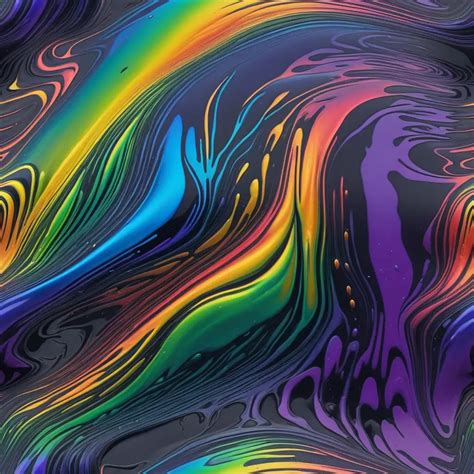Shimmering Hues of an Environmental Enigma
Oil slicks, often seen as remnants of environmental mishaps, have captivated human imagination with their mesmerizing array of colors. These iridescent patterns, formed by a thin layer of oil floating on water, reflect and refract light into a stunning spectrum, ranging from vibrant greens to deep purples and even ethereal silver and gold.

Understanding Oil Slick Colors
The kaleidoscopic hues of oil slicks are caused by the interaction of light with the surface of various organic compounds found in petroleum. These molecules act as microscopic prisms, bending and splitting light waves to create different wavelengths of color.
- Green: Chlorophyll and other pigments in plant matter often mix with oil slicks, giving them a verdant hue.
- Blue: Short wavelengths of light are scattered more by oil slicks, resulting in a bluish appearance.
- Purple: A combination of blue and red light produces shades of purple.
- Silver and Gold: Thicker oil slicks can refract light in a way that resembles metallic surfaces.
Benefits and Applications of Oil Slick Colors
Despite their ecological concerns, oil slick colors have inspired advancements in various fields:
Art and Design: The vibrant colors and abstract patterns of oil slicks have been embraced by artists, photographers, and designers, who use them to create captivating works of art, fashion, and home décor.
Cosmetics: The iridescent properties of oil slick colors are harnessing in cosmetics, such as eye shadows, nail polish, and hair dyes, to create eye-catching and otherworldly effects.
Textiles: Oil slicks have inspired unique textile designs, where fabrics mimic the iridescent sheen of water pollution, resulting in garments that shift and change color under different lighting conditions.
Industrial Applications: The color-changing properties of oil slicks have applications in fields such as solar energy, where they could potentially enhance light absorption and cell efficiency.
Using Olloximetry for Environmental Monitoring
Oil slick colors provide valuable information about the composition and concentration of oil in water bodies. Scientists use a technique called “olloximetry” to analyze the spectral signatures of oil slicks, allowing them to identify the type of oil and estimate its thickness and extent. This data plays a critical role in environmental monitoring, oil spill cleanup efforts, and assessing the impact of oil pollution on marine ecosystems.
Environmental Concerns and Solutions
While oil slicks can be visually captivating, they pose significant environmental threats. Oil spills contaminate water bodies, harming marine life, disrupting ecosystems, and affecting coastal communities that rely on fishing and tourism.
Addressing the issue of oil slicks requires a multi-pronged approach:
- Prevention: Strict regulations on oil transportation and handling practices can help prevent spills.
- Spill Cleanup: Rapid and effective spill response protocols are essential to minimize environmental damage.
- Research and Innovation: Ongoing research focuses on developing new technologies for more efficient oil spill cleanup methods and containment devices.
Customer Needs and Benefits
Consumers and businesses are increasingly seeking sustainable solutions that align with their environmental values. Providing products and services that address oil slick pollution can tap into this growing market demand. By developing innovative applications for oil slick colors, businesses can:
- Enhance Brand Image: Associate themselves with environmental responsibility and sustainability.
- Meet Customer Demand: Cater to consumers who prioritize eco-friendly products and support companies that share their values.
- Create New Revenue Streams: Explore the commercial potential of oil slick colors in various industries, such as art, fashion, and cosmetics.
Pros and Cons of Oil Slick Applications
Pros:
- Captivating Aesthetics: The iridescent colors and abstract patterns of oil slicks create visual interest and appeal.
- Industrial Versatility: Oil slick colors have applications in diverse fields, including energy, textiles, and cosmetics.
- Environmental Awareness: Using oil slick colors in products and services can raise awareness about environmental issues.
Cons:
- Ethical Concerns: Some may question the use of oil slick colors, given their association with environmental pollution.
- Sourcing Issues: Obtaining oil slick materials for commercial applications may pose ethical and environmental challenges.
- Limited Availability: The availability of oil slick materials can vary depending on the frequency and severity of oil spills.
Conclusion
Oil slick colors, once a symbol of environmental degradation, are now inspiring a spectrum of applications in art, design, and industry. By embracing the transformative power of these iridescent hues, we can not only create visually stunning works but also raise awareness about environmental issues and contribute to sustainable solutions.
